The Megapixels Myth
Quality optics matters more than megapixels
| |

|
Myth: "More megapixels equals higher quality"
|
|
Next Article >>
The larger the digital camera megapixel number, the better the camera and
digital camera and images, right? The answer may surprise you, but from my
personal experience, the answer is a resounding NO! A digital camera with
a higher megapixels number may be better than a lower megapixel camera,
but it does not mean that it must be better.
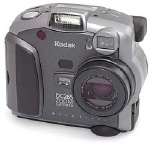
Kodak DC265
|
Kodak DC265 (1.5MP):
I purchased the Kodak DC265 in 1999. At the time, the DC265 was considered a semi-pro
1.5 MP digital camera. It took really fantastic digital pictures. Ultra clear pictures
with great color reproduction and a great flash (the flash is better than most
digital camera's even today). The only thing I did not like about this camera was the shutter
lag. You would press the shutter button, wait, wait, wait, and then click - picture taken.
Here are two blowups from a single picture taken with the Kodak DC265 -- one from
the picture center, and one from the picture edge. Notice the quality color and
no blurring:
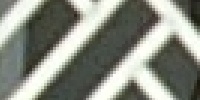
Center - GOOD quality |
|

Edge - GOOD quality |
I started to see 4MP cameras come onto the market, and was about to go on a family
vacation in 2003. Someone recommended the Casio Exilim to me, so I gave it a try.
Casio Exilim 4 (4MP):
I tried out the Exilim camera and I was initially impressed. However, I was
quickly disappointed once I examined the pictures taken by the camera.
Quality overall was very poor (compared to the Kodak DC265). There was color fringing
all over the picture and there was significant blurring around the edges of pictures.
Here are two blowups from a single picture taken with the Casio Exilim 4 -- one from the
picture center, and one from the picture edge. Notice the purple color fringing
and blurring:
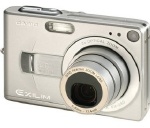
Casio Exilim 4
|

Center - FAIR quality |
|
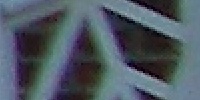
Edge - BAD blurring |
To test image detail, I set up a side by side test between the new Casio and my old Kodak
photographing a car at a distance and then attempting to read the license plate (both
camera framing the scene the same).
Looking at both photographs magnified in the computer indicated that the 4MP Casio camera
was no better than the Kodak 1.5MP camera at resolving detail. But how was that
possible? The bottom line was simple -- the Casio had more megapixels, but the optics
were much poorer -- resulting in pictures that we not even a good (both color wise and
quality) as the old 1.5 MP Kodak DC265.
When 5MP cameras became widely available in 2004, I decided to once again look for
a replacement for my aging DC265. A panorama web site highly recommended the Canon G5.
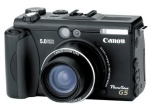
Canon G5
|
Canon G5 (5MP):
When I tried the 5MP Canon G5, I found that it had a huge 'blue cast'
(Chromatic Aberration)
problem -- so bad, in fact, that I
wrote an article
on the subject. A quick search on the Internet turned up a lot of information
on this known problem with the camera. Even more frustrating was Canon's
ridiculous reply to my technical support question on the 'blue cast' problem -- which
turned me off to Canon as a company.
Once again, the quality of the optics was the issue.
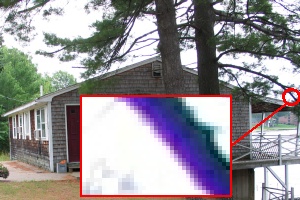
Canon G5 Blue Cast Problem
| |
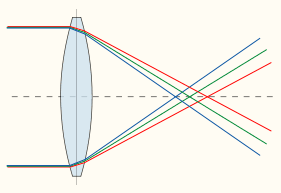
Chromatic Aberration
|
Enough was enough. After searching the internet, I found the
Digital Photography Review (dpreview.com)
web site, which appeared to be an independent review of many high-end
digital cameras. I finally settled upon a DSLR (digital SLR), the Nikon D70,
which the site 'highly recommended', even when compared to other digital cameras.
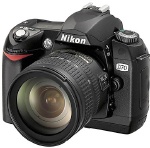
Nikon D70
|
Nikon D70 (6MP):
This camera is nothing short of amazing. The quality of images
is outstanding. The speed is really fast -- instant 'on' and effectively
no 'shutter lag'. When you turn the camera on, it is on - there is no
waiting. When you press the shutter button, there is no waiting -
it takes the picture just like a SLR. The flash is OK -- not as
good as my old Kodak DC265, but the external flash makes up for that.
Over 1000+ shots in a single battery charge. I can't say enough good
things about this DSLR.
And when you look at the camera, the size of the glass/optics in the lens,
I think says it all -- and why cameras with lenses a fraction of the
size can not compare.
Here are two blowups from a single picture taken with the Nikon D70 -- one from
the picture center, and one from the picture edge. Notice the high quality
(no color fringing and no blurring):
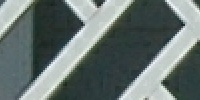
Center - Excellent quality |
|
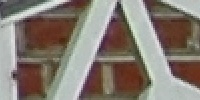
Edge - Excellent quality |
The bottom line: The bottom line is that the number of megapixels, while
sometimes initially impressive, is nothing compared to quality optics. Avoid
cameras with cheap optics. Examine the pictures you take with any new digital
camera and review them in the computer (blown up) with a critical eye. If you
can, stick with a good digital SLR instead of a compact digital camera. And while
the tradeoff of a DSLR is increased size, the quality optics results in quality
images that very few, if any, compact digital cameras can match.
|

